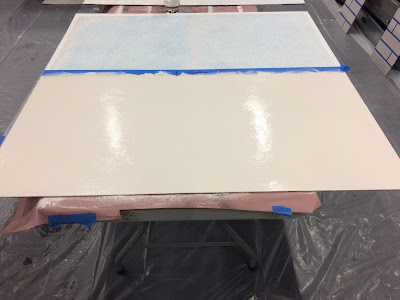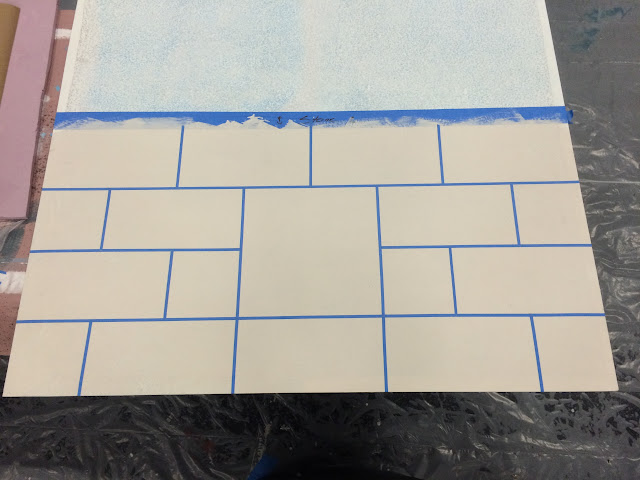With our stone texture dry and the pattern punched, we can now move on to finishing the stonework with spattering. But wait! I forgot to mention the second stone texture. You can see it in the picture below where we used a reddish color to sponge on in a few places for added depth. This step was done
before removing the painter's tape. The photograph was taken after the tape was removed to give you a better idea what the finished product will look like. The spattering was done by taking a chip brush and stir stick, then after charging the brush, running it over the edge of the stick to fling paint on the board. Careful not to get too much paint though or you'll get globs all over the place!
 |
| Finished Stone Texturing Waiting for Pounce |
After letting the spatter dry, we could return to our paper with the medallion and pounce it onto our board. To begin, we taped two corners onto the board, which allowed us to peel the design back during pouncing to make sure the charcoal was coming through. Once the design was transferred, we removed the paper and drew in the lines very lightly, using a compass to maintain the original true circles. The graphite was then blotted away with a damp sponge, leaving the pencil marks behind. It was kind of a bear to get the charcoal up (I was a little heavy handed with it), and had some trouble with it smudging over onto my grout.
 |
| Pounced and Sketched Medallion |
 |
| Shadow Lines Only |
Now comes the tricky part. In order to give the impression of an actual shadow, we took a
minuscule amount of premixed shadow color and added it to some water on the pallet. The way the shadowing technique works is that the paint is applied so conservatively and thinly that you can still see the color and texture underneath. Getting the shadow to the proper thickness took some experimenting, but once I got the hang of it, the most difficult part was avoiding hard edges.
Naturally, shadows have a tendency to kind of fade out in a very soft edge, and working the paint out until it faded on its own was the best way to get close to the natural appearance. Once the thin base was laid down, we could come back with more shadow and crisp up the deeper shadows under edges before laying in the highlights. Our highlight color was also premixed, and the instructor made the observation that the reason the 3D effect works is because each highlight is countered by a shadow, and vice versa. The highlight demanded crisper lines and a "bleaching" of the texture underneath with a heavier hand at its brightest.
 |
| Comparison of original image (left) with finished product (right). |
























